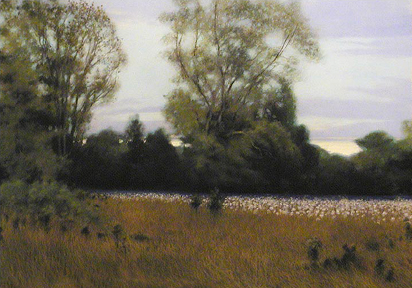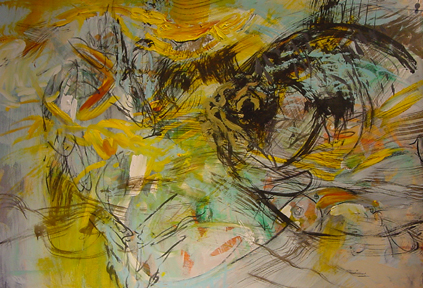

| For more information about this article or gallery, please call the gallery phone number listed in the last line of the article, "For more info..." |
January Issue 2004
Gallery 80808 in Columbia, SC, Offers Winter Exhibition: Chesley, Williams, Wimberly, Yaghjian
In what is fast becoming a after-the-holidays art tradition in the South Carolina Midlands, Stephen Chesley, Mike Williams, Edward Wimberly, and David Yaghjian are having their third annual group show at Gallery 80808 in Columbia, SC. The show brings together some of the most powerful artists in the Carolinas. The exhibition runs from Jan. 23 through Feb. 5, 2004.
Chesley (b. 1952) will show his moody landscapes as well as abstract metal sculpture. Williams (b. 1963) will include his expressive new fish paintings, drawings, recent landscapes, and sculptures. Wimberly (b. 1942) will not only show his signature surrealist and magic-realist paintings but also paintings of people, a new development for him. Yaghjian (b. 1948) will exhibit his intimate streetscapes and at times closely cropped renderings of architectural structures.
Chesley, Williams, and Wimberly held their first show as a group during the 2001-2002 holiday season. For their second show together, in Jan. 2003, they also invited Yaghjian. "David had not long before moved to Columbia from Atlanta," Williams said. "Stephen, Ed and myself saw his work and admired it. And we liked David personally, so we thought he would be a good addition to our group. That's really what this is all about. It's a group of artists who are friends, admire each other's skills, feel they all maintain high professional and artistic standards, and have an affinity for each other personally. Because of all that, we like to show together."
 David Yaghjian
David Yaghjian
Columbia native Yaghjian was happily surprised when the other three invited him to join. He had a solo show in Columbia after his return from Atlanta in 2000. He had had two other shows in the city in the early 1990s. He also comes from a well-known family of Columbia artists. But in a sense, Yaghjian was somewhat of a new kid on the block in his hometown. "That these three guys thought I should show with them meant a lot to me," Yaghjian said. " They are, after all, among the most respected artists in this area."
For Yaghjian, painting is therapeutic. "Painting is necessary for me. Over the years, I have tried not to paint. I've tried other professions like carpentry or picture framing, but each time away from painting would turn me into an unhappy, intolerant, and intolerable person. When I am painting, I am calm."
It's the act of painting that is primary to Yaghjian. The subject matter provides the basis for his painting or, as he puts it, "the impetus for the lyric." That basis has for the past several years been architecture. "Buildings can be seen as echoes, reiterations of their builders and inhabitants," Yaghjian said. "And buildings offer wonderful opportunities for the contemplation of light and color on large planes."
It's this Hopperesque aspect of Yaghjian's paintings that connects his work to that of Chesley, who also is concerned with the effects of light in his landscapes, cityscapes or beach scenes. Light allows Chesley to make more obvious the drama in the ordinary, as opposed to painting what is obviously dramatic. " I am fascinated by light," he said.
 Stephen Chesley
Stephen Chesley
Chesley's scenes are moody, whether it's a lonesome moodiness like Edward Hopper's or the more romantic and poetic kind of 19th century American painters, including Albert Pinkham Ryder, George Innes, and Ralph Albert Blakelock. In his sculpture, Chesley, who lives in Columbia, tries to incorporate Hopper's solidity as well as Ryder's simple straightforwardness. American David Smith is an important sculptural influence on his metal work.
Chesley's more robust
sculptures consist of larger triangular and other geometric forms
that are stacked to take on a vertical shape with organic qualities.
The more delicate, intricate pieces are built up from relatively
small, rectangular and angular pieces of metal interrupted by
rounded shapes or longer, narrow strips. Welded together, those
pieces form a seemingly random, dynamic composition. Their critical
mass is at the heart of the sculptures, where their considerable
movement takes off.
"With the sculptures I am steering away from a signature
medium," Chesley said. "Many artists have tested their
ability to shift mediums. Gauguin did it with ceramics and wood,
Picasso with just about anything. What I try to do is create abstractions,
abstract sculptures, but give them a figurative element."
 Mike Williams
Mike Williams
Williams' metal sculptures also have both strong geometric and organic elements, including the shapes, forms, and details of the subject matter with which he made his mark in the early 1990s: fish. Abandoning the subject of fish in his paintings in the past seven years, Williams has recently engaged it again. He has done so in lively, direct drawings and paintings consisting of an onslaught of energetic marks and techniques.
"After doing a couple of pieces for a commission in December 2002, I felt a strong desire to begin a new series of work with fish as the primary compositional element," the Sumter, SC, native and Columbia resident said. "I am focusing more deliberately and intentionally on the formal aspects of painting now, striking harmonies between colors, suggesting texture, and implying movements, contrasting the movements of paint and other mediums."
 Edward Wimberly
Edward Wimberly
Wimberly, born, raised, and living in St. Matthews, SC, will show
some paintings that present a new direction in his work. There
will be some of his well-known images of cups and chairs finding
themselves in a surreal or at least unusual context. "That's
my stock in trade," Wimberly said, "But I am also going
to put a couple of pictures of people in the show. I don't usually
do people in my shows. They won't be straightforward portraits.
They are personifications of ideas, the way the Greeks did. The
Greeks personified ideas as human beings."
Wimberly reserves straightforward portrait painting for commissioned
work, his second line of art production. Doing commissioned portraits
for decades is now beginning to have an impact on his exhibition
art, he suspects. "I am finally beginning to have ideas about
people. After all these years."
Wimberly in 1975 received his BFA from Atlanta College of Art. Four years later, he added an MFA from Clemson University. He has shown his work in the Columbia Museum of Art, the Gibbes Museum of Art in Charleston, the SC State Museum, the Greenville County Museum of Art and in museums in Florida and New York. In 1983, he received a SC Arts Commission Visual Arts Fellowship.
Williams has been making
art since 1988, two years before he graduated with a BFA studio
degree from the University of South Carolina. His work has been
shown in individual and group exhibitions across the Southeast
and beyond, including the German city of Kaiserslautern. Williams
was part of a 2000 group show at the SC State Museum in an exhibition
that also traveled to the Lake County Museum in Chicago.
In addition to many private and corporate collections in the United
States, Germany, and the Netherlands, Williams' work is in the
Columbia Museum of Art and in public spaces in Columbia and Sumter.
A large show of his sculpture is on view on the campus of the
University of South Carolina at Spartanburg. His 20-foot high,
stainless steel sculpture at Midlands Technical College in Columbia
is his largest to date.
Chesley grew up in Virginia Beach, VA. In 1975, he received a BA in urban studies from Richmond's Virginia Commonwealth University. In 1980, he earned an MA in urban regional planning from Clemson University's School of Architecture. After a brief stint as a planner, Chesley turned to painting, building on a lifelong love of drawing and a somewhat belated realization that his talent was out of the ordinary.
Chesley was included in a juried, 1987 exhibition at the Smithsonian Institution in Washington, DC. He also has exhibited in Kaiserslautern, Germany; at Florida's Orlando Museum of Art; Kentucky's Owensboro Museum of Fine Art; the Montana College Gallery at Dillion; Alabama's Montgomery Museum of Fine Art and Opelika Fine Art Center; and at Georgia's Savannah College of Art and Design, where he was part of two nationally juried exhibitions. In 1996, he received a regional fellowship from the National Endowment for the Arts.
Yaghjian studied painting at Amherst College in Massachusetts with Fairfield Porter. In the same state, he studied etching with Leonard Baskin. In New York City, at the Art Students League and the School of Visual Arts, he studied with Will Barnet and Chaim Koppelman. He has shown in several Atlanta galleries, at Blue Spiral 1 in Asheville, NC, and several times at the former Morris Gallery in Columbia. In March, Yaghjian will have a solo exhibition at Hampton III Gallery in Greenville, SC.
For more information
check our SC Institutional Gallery listings or call the gallery
at 803/252-6134 or 803/254-2234.
Carolina Arts is published monthly by Shoestring Publishing
Company, a subsidiary of PSMG, Inc.
Copyright© 2004 by PSMG, Inc., which published Charleston
Arts from July 1987 - Dec. 1994 and South Carolina Arts
from Jan. 1995 - Dec. 1996. It also publishes Carolina Arts
Online, Copyright© 2004 by PSMG, Inc. All rights reserved
by PSMG, Inc. or by the authors of articles. Reproduction or use
without written permission is strictly prohibited. Carolina
Arts is available throughout North & South Carolina.